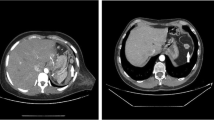Summary
Several clinical and laboratory studies have demonstrated the risk of sepsis in connection with encapsulated bacteria. The importance of clearing these organisms by the spleen is now well accepted. In contrast, the present work deals with the clearance of non-encapsulated gram-negative bacteria(Escherichia coli).
The animals used for the experiments (a heterogenous population of rabbits) were divided into a control group, a splenectomized group, and an autotransplanted group. The histological examination of the splenic transplants revealed typical splenic tissue including lymphatic follicles with germinal activity 42 days after transplantation.
For estimation of the clearance capacity different amounts of bacteria were injected i.v. into the rabbits, and colony-forming bacterial cells in the blood were counted at certain intervals. In the control group no bacteria could be detected in the blood after 7 min. All animals of the splenectomized and autotransplanted groups showed a remarkable decrease in clearance efficiency (no bacteria in the blood after 19 min). No difference in the clearance kinetics could be shown between splenectomized and autotransplanted animals. Measuring the uptake of bacterial cells into different organs elicited low incorporation in the spleen as compared to non-immunocompetent organs, but no difference between normal spleen and splenic replants. However, saturation withE. coli cells reached higher limits in the normal spleen than in autotransplants.
The immunologic capacity with respect to IgM-producing lymphocytes was measured by the hemolytic plaque assay. The results showed a severe malfunction of the autotransplants as compared to the normal spleen (only 2% of the activity of the control group).
Vaccination againstE. coli increased the clearance efficiency in all three groups. The data presented in this paper point out that several functions of the spleen cannot be carried out by autotransplants. The reasons, therefore, may be limited transplant mass and/or decreased specific functions.
Similar content being viewed by others
References
Buntain WL, Lynn HB (1979) Splenorrhaphy: Changing concepts for the traumatized spleen. Surgery 86:748–760
Cooper MJ, Williamsen RCN (1984) Splenectomy: Indications, hazards and alternatives, Br J Surg 71:173–180
Dürig M, Heberer M, Wadström J, Gratwohl A, Fridrich R, Harder F (1982) Die Replantation autologen Milzgewebes in das Omentum majus: eine Alternative zur Splenektomie. Helv Chir Acta 49:795–798
Horton J, Odgen ME, Williams S, Coln D (1982) The importance of splenic blood flow in clearing pneumococcal organisms. Ann Surg 195:172–176
Miller JH (1977) Experiments in molecular genetics. Cold Spring Harbor, New York
Jerne NK, Henry C, Nordin AA, Fuji H, Koros AMC, Lefkovits I (1974) Plaque-forming cells: Methodology and theory. Transplant Rev 18:130
King H, Shumaker HB (1952) Splenic studies: Susceptibility to infection after splenectomy performed in infancy. Ann Surg 136:239
Laurell CB (1972) Electrophoretic and electroimmunochemical analysis of proteins. Scand J Clin Invest [Suppl] 29:124
Lanng-Nielsen J, Andersen HK, Hansen KB, Sasko P, Kristensen ES, Sorensen FH (1983) Protective effect of implanted autologous splenic tissue in splenectomized rats exposed to i.v.Streptococcus pneumoniae. Scand J Haematol 30:367–373
Leonhard AS, Giebink GS, Baesl TJ, Krivit W (1980) The overwhelming post splenectomy sepsis problem. World J Surg 4:423–432
Pabst R, Kamran D, Creutzig H (1984) Splenic regeneration and blood flow after ligation of the splenic artery or partial splenectomy. Am J Surg 147:382–386
Pabst R, Reilmann H (1980) Regeneration of heterotopically transplanted autologous splenic tissue. Cell Tissue Res 209:137–143
Patel J, Williams JS, Naim JO, Hinshaw JR (1982) Protection against pneumococcal sepsis in splenectomized rats by implantation of splenic tissue into an omental pouch. Surgery 91:638–641
Patel J, Williams JS, Shigel B, Hinshwa JR (1981) Preservation of splenic function by autotransplantation of traumatized spleen in men. Surgery 90:683–688
Pimpl W, Wayand W, Thalhamer J, Trost A (1984) Preparation and weight of splenic transplants — an experimental study. Langenbecks Arch Chir 362:5–16
Scher KS, Wrocynski F, Coil JA (1982) The effect of splenectomy on gram-negative bacterimia. J Trauma 22:407–409
Seufert RM, Böttcher W, Munz D, Heusermann U (1981) Erste klinische Erfahrungen mit der heterotopen Autotransplantation der Milz. Chirurg 52:525–530
Sherman R (1980) Perspective in management of trauma to the spleen. J Trauma 20:1–13
Singer DB (1973) Postsplenectomy sepsis. Perspect Ped Pathol 1:285–311
Thalhamer J, Freund J (1984) Cascade immunization: A method of obtaining polyspecific antisera against crude fractions of antigens. J Immunol Method 66:245–251
Author information
Authors and Affiliations
Rights and permissions
About this article
Cite this article
Thalhamer, J., Pimpl, W. & Pattermann, M. The role of the spleen and splenic autotransplants in clearing experimental bacteremia caused by the gram-negative bacteriumEscherichia coli . Res. Exp. Med. 186, 229–238 (1986). https://doi.org/10.1007/BF01852049
Received:
Accepted:
Issue Date:
DOI: https://doi.org/10.1007/BF01852049




